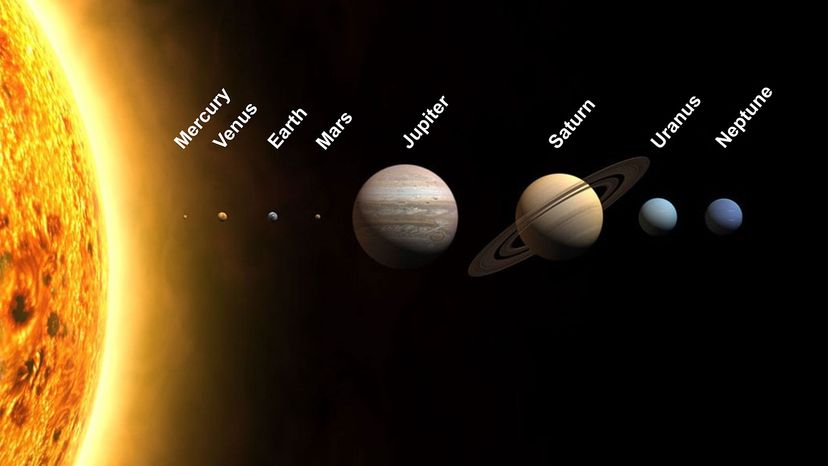By: Valerie Stimac|Updated: Jul 12, 2023

Over the past 60 years, humans have begun to explore our solar system in earnest. From the first launches in the late 1950s until today, we've sent probes, orbiters, landers, and even rovers (like NASA's Perseverance Rover that touched down on Mars in February 2021) to every planet in our solar system. But can you name all eight of those planets in order? (Yes, there are only eight – not nine. Pluto got "demoted" in 2006.) And can you put them in the correct order?
In case you're a little rusty, we'll break down some common ways to order the planets plus a few tricks to help you remember them going forward. Let's start with the distance from the sun.
Advertisem*nt
The most common way to order the planets is by their distance from the sun. Using this method, the planets are listed in the following order:
Contents
- Planets in Order From the Sun
- How to Remember the Order of the Planets
- You Can Order the Planets in Other Ways
- The Planets in Order by Size
- Planets With the Most Moons
Planets in Order From the Sun
- Mercury - 0.39 AU from the sun
- Venus - 0.72 AU
- Earth - 1.00 AU
- Mars - 1.52 AU
- Jupiter - 5.20 AU
- Saturn - 9.54 AU
- Uranus - 19.20 AU
- Neptune - 30.06 AU
AU stands for astronomical units – it's the equivalent to the average distance from Earth to the sun (which is why Earth is 1 AU from the sun). It's a common way astronomers measure distances in the solar system that accounts for the large scale of these distances. To put it another way, Mercury, which is closest, is 35.98 million miles from the sun, while Neptune, the farthest, is 2.79 billion miles from the sun. Earth is 92.96 million miles from the sun.
Advertisem*nt
How to Remember the Order of the Planets
There are many handy expressions to remember the order of the planets. These are typically mnemonics which use the first letter of each planet's name to come up with a phrase that's easier to remember.
Here are some of the most common (and silliest) ones:
Advertisem*nt
- My Very Excellent Mother Just Served Us Noodles (or Nachos)
- My Very Easy Method Just Speeds Up Names
- My Very Expensive Malamute Jumped Ship Up North
In each case, "M" stands for "Mercury," "V" for "Venus," and so on. You can also try to remember them with a few rhyming verses:
Amazing Mercury is closest to the Sun,Hot, hot Venus is the second one,Earth comes third: it’s not too hot,Freezing Mars awaits an astronaut,Jupiter is bigger than all the rest,Sixth comes Saturn, it's rings look best,Uranus sideways fallsAnd along with Neptune,They are big gas balls.
Finally, if you are musically inclined, there are a few songs that may help you remember. Two popular ones are Mr. R's Planet Song and The Planet Song from Kids Learning Tube.
Advertisem*nt
You Can Order the Planets in Other Ways
While most people want to know the order of the planets by distance, there are other ways to order the planets that you might be curious about.
For example, if you order the planets by size (radius) from biggest to smallest, then the list would be:
Advertisem*nt
The Planets in Order by Size
- Jupiter (43,441 miles/69,911 kilometers)
- Saturn (36,184 miles/58,232 km)
- Uranus (15,759 miles (25,362 km)
- Neptune (15,299 miles/24,622 km)
- Earth (3,959 miles/6,371 km)
- Venus (3,761 miles/6,052 km)
- Mars (2,460 miles/3,390 km)
- Mercury (1,516 miles/2,440 km)
Or you could order the planets by weight (mass). Then, the list from most massive to least massive would be: Jupiter (1.8986 x 1027 kilograms), Saturn (5.6846 x 1026 kg), Neptune (10.243 x 1025 kg), Uranus (8.6810 x 1025 kg), Earth (5.9736 x 1024 kg), Venus (4.8685 x 1024 kg), Mars (6.4185 x 1023 kg), and Mercury (3.3022 x 1023 kg). Interestingly, Neptune has more mass than Uranus, even though Uranus is larger! Scientists can't put a planet on a scale, so to determine mass, they look at how long it takes nearby objects to orbit the planet and how far from the planet those objects are. The heavier the planet, the stronger it pulls on nearby objects.
Advertisem*nt
Planets With the Most Moons
Finally, a fun way to order the planets is by the number of moons they have. We'll start with the planet that has the most:
- Saturn (146)
- Jupiter (95)
- Uranus (27)
- Neptune (14)
- Mars (2)
- Earth (1)
- Venus and Mercury (both zero)
(Note that these numbers include provisional moons that are still being confirmed by astronomers.)
Advertisem*nt
In short, there are a number of ways to order and reorder the planets based on different facts about them; as long as you remember there are eight in total that's what counts. (Sorry, Pluto!)
Is Pluto a Planet?
Speaking of Pluto, what's the deal? After its discovery in 1930, Pluto was classified as a planet. However, in 2006, the International Astronomical Union downgraded Pluto from "planet" to "dwarf planet." This is because the definition of a planet means that it has cleared its orbit of other objects (which Pluto has not done, as it shares its space with many Kuiper Belt objects). Pluto is one of five dwarf planets in our solar system – and it's not even the largest one (that's Eris).
Advertisem*nt
Cite This!
Please copy/paste the following text to properly cite this HowStuffWorks.com article:
Citation
Related Links
Advertisem*nt
Advertisem*nt
Loading...
\n\n\t\t\t\t
`;t.byline_authors_html&&(e+=`By: ${t.byline_authors_html}`),t.byline_authors_html&&t.byline_date_html&&(e+="|"),t.byline_date_html&&(e+=t.byline_date_html);var i=t.body_html.replaceAll('"pt','"pt'+t.id+"_");return e+=`\n\t\t\t\t
\n\t\t\t\t
\n\n\t\t\t\t
${i=i.replaceAll("#pt","#pt"+t.id+"_")}
\n\n\t\t\t
`}(a);this.loadedDiv.innerHTML+=n,document.title=a.title+" | HowStuffWorks";let s="content-loaded-"+a.id,l=document.getElementById(s);l.dataset.contentId=a.id;let o=l.querySelectorAll(".lazyload");HSW.utilities.lazyLoadElements(o),HSW.ux.editorial.init({twitter:!0,facebook:!0,instagram:!0}),l.querySelectorAll(".toc a").forEach(t=>{t.addEventListener("click",t=>{t.preventDefault();let e=t.target.dataset.target,i=document.querySelector("a[name='"+e+"']");i?i.scrollIntoView({behavior:"auto"}):console.error("Unable to locate target with name "+e)})});try{if(userData.adsActive)if(HSW.utilities.isMobile()){l.querySelectorAll(".ad-mobinline").forEach(t=>{t.setAttribute("id","ad-wrap-mobinline"+r),t.childNodes[0].setAttribute("id","ad-div-mobinline"+r),void 0!==HSW.ads&&HSW.pq.add(()=>{HSW.ads.addNewUnits(["ad-div-mobinline"+r])},"ads"),r++})}else{let t=document.createElement("div");t.setAttribute("id","ad-after-"+e),t.classList.add("ad-inline","mb-8","bg-gray","w-max-full","h-min-90","text-center");let a=document.createElement("div");a.setAttribute("id","ad-div-inline"+i),t.appendChild(a),l.after(t),void 0!==HSW.ads&&HSW.pq.add(()=>{HSW.ads.addNewUnits(["ad-div-inline"+i])},"ads")}}catch(t){console.error(t)}if(window.setupSinglePageUX(l),history.pushState)try{history.pushState(null,a.title+" | HowStuffWorks",a.href)}catch(t){console.warn(t)}var c=[];a.taxonomy.forEach((t,e)=>{c[e]=t.title.toLowerCase()});var d=c.join("/"),h=[];a.authors.forEach((t,e)=>{h[e]=t.first_name.toLowerCase()+" "+t.last_name.toLowerCase()});var g=h.join(",");pageMetricsData.href=a.href,pageMetricsData.title=a.title,pageMetricsData.tax=d,pageMetricsData.aType=a.asset_type,pageMetricsData.cType=a.type+"-continuous",pageMetricsData.template=a.template,pageMetricsData.source=a.source,pageMetricsData.sponsor=a.sponsor,pageMetricsData.author=g,pageMetricsData.contentid=a.id,pageMetricsData.image=a.hero_image,pageMetricsData.page=0,pageMetricsData.pubDate=a.publish_date.slice(0,10),pageMetricsData.editDate=a.last_editorial_date.slice(0,10);const u=/[^\da-z_]/i;let p=HSW.utilities.isMobile()?"hsw_lite":"hsw";a.taxonomy.slice(1,3).forEach((t,e)=>{p+="|"+t.title.replace(u,"").toLowerCase()}),pageMetricsData.adUnit=p,Alpine.store("share",{title:pageMetricsData.title,url:pageMetricsData.href,image:pageMetricsData.image}),function(t,e){let i=t.href.split(".com/").pop();dataLayer.push({event:"virtual-page-view",virtualPageUrl:i,virtualPageTitle:document.title,pageNbr:0}),dataLayer.push({event:"raw-event-interactive",eventCategory:"page-interaction",eventAction:"continuous-load",eventLabel:"new-content",eventValue:e+1,virtualPageUrl:t.href})}(a,this.items.length);const m={...pageMetricsData};t.items.push(m);for(var f=document.getElementsByClassName("new-content-loaded"),v=0;v